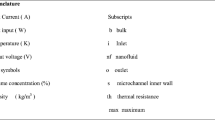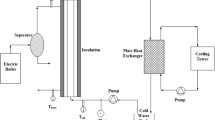Abstract
The microchannels are device used to remove high heat fluxes from smaller area. In this experimental research work the heat transfer performance of nanofluids of Al2O3/water and CuO/water were compared. The important character of such fluids is the enhanced thermal conductivity, in comparison with base fluid without considerable alteration in physical and chemical properties. The effect of forced convective heat transfer coefficient was calculated using serpentine shaped microchannel heat exchanger. Furthermore we calculated the forced convective heat transfer coefficient of the nanofluids using theoretical correlations in order to compare the results with the experimental data. The heat transfer coefficient for different particle concentration and temperature were analysed using forced convection heat transfer using nanofluids. The findings indicate considerable enhancement in convective heat transfer coefficient of the nanofluids as compared to the basefluid. The results also shows that CuO/water nanofluid has increased heat transfer coefficient compared with Al2O3/water and base fluids. Moreover the experimental results indicate there is increased forced convective heat transfer coefficient with the increase in nano particle concentration.













Similar content being viewed by others
Abbreviations
- A:
-
Cross section area (m2)
- Dh :
-
Hydraulic diameter (mm)
- H:
-
Channel height (mm)
- h:
-
Convective heat transfer coefficient (kW/m2 K)
- k:
-
Thermal conductivity (W/mK)
- L:
-
Test section length (mm)
- l:
-
Length of the vertical passage (mm)
- Lch :
-
Total channel length (mm)
- m:
-
Mass flow rate (kg/s)
- N:
-
Number of vertical passage
- Nu:
-
Nusselt number
- Pr:
-
Prandtl number
- q:
-
Actual heat flux (kW/m2)
- Qs :
-
Heat supplied (W)
- Q:
-
Heat transfer (W)
- r:
-
Radius of the circular passage (mm)
- Re :
-
Reynolds number
- T:
-
Temperature (K)
- u:
-
Velocity (m/s)
- W:
-
Channel width (mm)
- f:
-
Friction factor
- (Cp)nf :
-
Nanofluid heat capacity (J/kg K)
- ρbf :
-
Density of base fluid (kg/m3)
- ρp :
-
Density of particle (kg/m3)
- (Cp)p :
-
Particle heat capacity (J/kg K)
- Kp :
-
Thermal conductivity of particle (W/mK)
- Kbf :
-
Thermal conductivity of base fluid (W/mK)
- µnf :
-
Viscocity of nanofluid (kg/m2 s)
- µbf :
-
Viscocity of basefluid (kg/m2 s)
- hf :
-
Head losses
- µ:
-
Dynamic viscosity (kg/m2 s)
- Δp:
-
Pressure drop (kPa)
- ρ:
-
Density (kg/m3)
- φ:
-
Volume fraction of nanoparticles (%)
- bf :
-
Base fluid
- exp:
-
Experimental
- in:
-
Inlet
- m:
-
Mean
- nf :
-
Nanofluid
- out:
-
Outlet
- p:
-
Particle
- th:
-
Theoretical
- w:
-
Wall
- Al2O3 :
-
Alumina
- CuO:
-
Copper oxide
References
Tuckerman DB, Pease RFW (1981) High-performance heat sinking for VLSI. IEEE Electron Device Lett 2:126–129
Singh R, Akbarzadeh A (2009) Sintered porous heat sink for cooling of high-powered microprocessors for server applications. Int J Heat Mass Transf 52:2289–2299
Hung T-C, Yan W-M, Wang X-D, Chang C-Y (2012) Heat transfer enhancement in microchannel heat sinks using nanofluids. Int J Heat Mass Transf 55:2559–2570
Choi SUS (1995) Enhancing thermal conductivity of fluids with nanoparticles. ASME FED 231:99–103
Lee S, Choi SUS, Li S, Eastman JA (1999) Measuring thermal conductivity of fluids containing oxide nanoparticles. ASME J Heat Transf 121:280–289
Koo J, Kleinstreuer C (2004) A new thermal conductivity model for nanofluids. J Nanopart Res 6:577–588
Lee J-H, Hwang KS, Jang SP, Lee BH, Kim JH, Choi SUS et al (2008) Effective viscosities and thermal conductivities of aqueous nanofluids containing low volume concentrations of Al2O3 nanoparticles. Heat Mass Transf 51:2651–2656
Bar-Cohen A, Wang P, Rahim E (2007) Thermal management of high heat flux nano electronic chips. Microgravity Sci Technol 19(3):48–52
Ameel TA, Warrington RO, Wegeng RS, Drost MK (1997) Miniaturization technologies applied to energy systems. Energy Convers Manag 38:969–982
Kandilkar S, Garimella S, Li D, Colin S, King MR (2006) Heat transfer and fluid flow in minichannels and microchannels. Elsevier Ltd, Great Britain
Jung Jung-Yeul, Hoo-Suk Oh, Kwak Ho-Young (2009) Forced convective heat transfer of nanofluids in micro-channels. Int J Heat Mass Transf 52:466–472
Qu W, Mudawar I (2005) A systematic method for optimal design of two-phase micro channels heat sink. ASME J Electron Packag 127(381):390
Lee J, Mudawar I (2006) Implementation of micro-channel evaporator for high heat flux refrigeration cooling applications. ASME J Electron Packag 128:30–37
Mehendal SS, Jacobi AM, Shah RK (2000) Fluid flow and heat transfer at micro- and meso-scales with application to heat exchanger design. Appl Mech Rev 53:175–193
Hung Tu-Chieh, Yan Wei-Mon (2012) Enhancement of thermal performance in double-layered microchannel heat sink with nanofluids. Int J Heat Mass Transf 55:3225–3238
Ho CJ, Chen W-C, Yan W-M (2014) Experiment on thermal performance of water-based suspensions of Al2O3 nanoparticles and MEPCM particles in a minichannel heat sink. Int J Heat Mass Transf 69:276–284
Peterson GP et al (1996) Forced convective heat transfer of single-phase binary mixtures through micro channels. Exp Therm Fluid Sci 12:98–104
Ho CJ et al (2010), An experimental investigation of forced convective cooling performance of a microchannel heat sink with Al2O3/water nanofluid. Appl Therm Eng 30(2–3):96–103
Author information
Authors and Affiliations
Corresponding author
Rights and permissions
About this article
Cite this article
Sivakumar, A., Alagumurthi, N. & Senthilvelan, T. Experimental investigation of forced convective heat transfer performance in nanofluids of Al2O3/water and CuO/water in a serpentine shaped micro channel heat sink. Heat Mass Transfer 52, 1265–1274 (2016). https://doi.org/10.1007/s00231-015-1649-5
Received:
Accepted:
Published:
Issue Date:
DOI: https://doi.org/10.1007/s00231-015-1649-5




